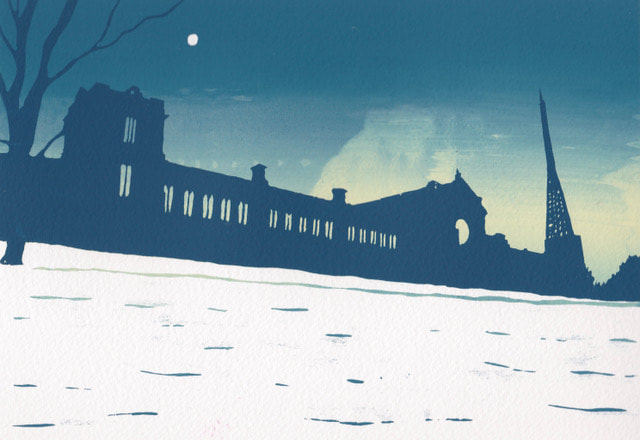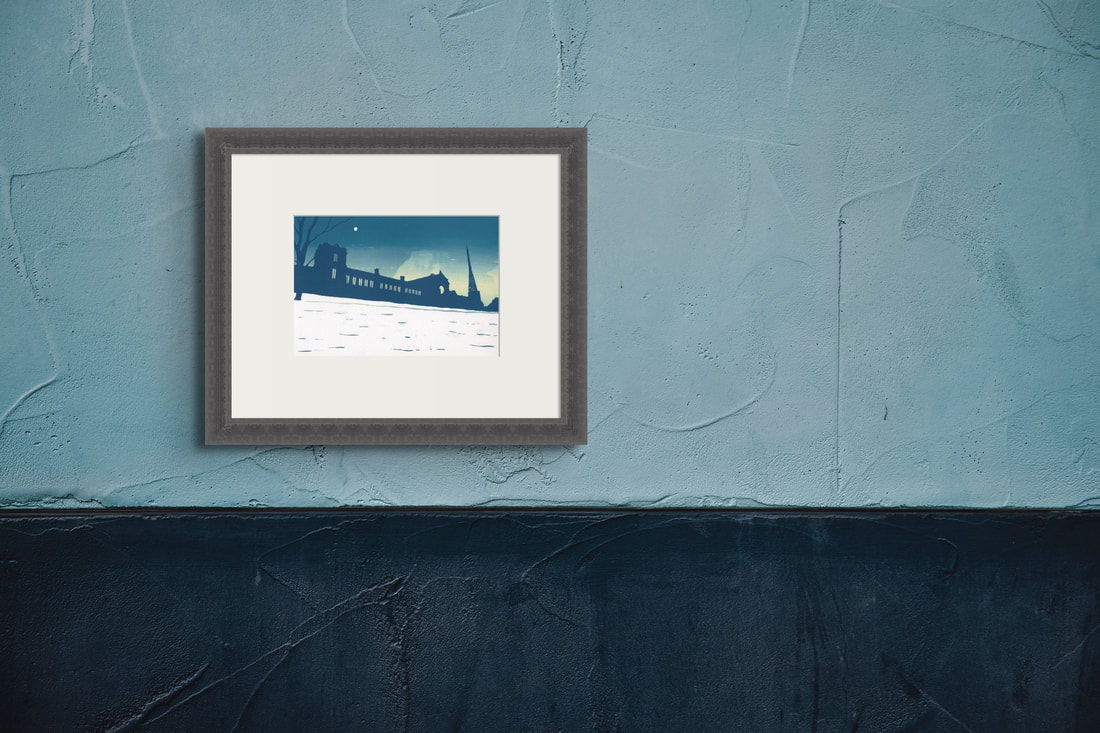Alexandra Palace by Ian Scott Massie
Variable Edition Reduction Screen Print - Edition of 9
16" x 12" Mounted size - 10" x 7" Image size
Available: unframed @ £130
To shop, please click here
16" x 12" Mounted size - 10" x 7" Image size
Available: unframed @ £130
To shop, please click here
ALEXANDRA PALACE
Shortly before the train leaves the outer suburbs of London the silhouette of Alexandra Palace appears on its hill above the railway. I’ve always thought it looked so exotic, set high against the clouds, above the monotonous rhythm of roofs and chimneys.
Crystal Palace was erected in Hyde Park for the Great Exhibition of 1851. The success of this elegant glass house led to a proposal to build a counterpart - a “Peoples Park” - in North London on the site of Tottenham Wood Farm.
Alexandra Park opened in 1863 (named after the Princess of Wales) and a banqueting hall, boating lake and racecourse were soon added. Designed by Alfred Meeson, the Palace itself was begun in 1864 and, after many delays, opened in 1873. It burned down two weeks later. With what must have been remarkable optimism the builder cleared the site, started work again and this time it didn’t burn down.
“Ally Pally” reopened in 1875. It was enormous, boasting a great hall seating 14,000, a 3,000-seat theatre and a concert room (later a roller skating rink) which could hold 3,500 people. Sadly, for all its attractions, both palace and park failed to pay their way. They were rescued by the surrounding councils who acquired them in 1900 for the benefit of the local population.
In addition to its regular programme of events the Palace was used in both wars as a refugee centre and an internment camp and, a little later, was home to a Cold War bunker (which was only deactivated in 1990). Alexandra Palace has hosted a long list of famous names from Gracie Fields to Pink Floyd but probably its lasting claim to fame will be its place in broadcasting history. In 1936, this was the where the BBC launched the world’s first television service.
Crystal Palace was erected in Hyde Park for the Great Exhibition of 1851. The success of this elegant glass house led to a proposal to build a counterpart - a “Peoples Park” - in North London on the site of Tottenham Wood Farm.
Alexandra Park opened in 1863 (named after the Princess of Wales) and a banqueting hall, boating lake and racecourse were soon added. Designed by Alfred Meeson, the Palace itself was begun in 1864 and, after many delays, opened in 1873. It burned down two weeks later. With what must have been remarkable optimism the builder cleared the site, started work again and this time it didn’t burn down.
“Ally Pally” reopened in 1875. It was enormous, boasting a great hall seating 14,000, a 3,000-seat theatre and a concert room (later a roller skating rink) which could hold 3,500 people. Sadly, for all its attractions, both palace and park failed to pay their way. They were rescued by the surrounding councils who acquired them in 1900 for the benefit of the local population.
In addition to its regular programme of events the Palace was used in both wars as a refugee centre and an internment camp and, a little later, was home to a Cold War bunker (which was only deactivated in 1990). Alexandra Palace has hosted a long list of famous names from Gracie Fields to Pink Floyd but probably its lasting claim to fame will be its place in broadcasting history. In 1936, this was the where the BBC launched the world’s first television service.





